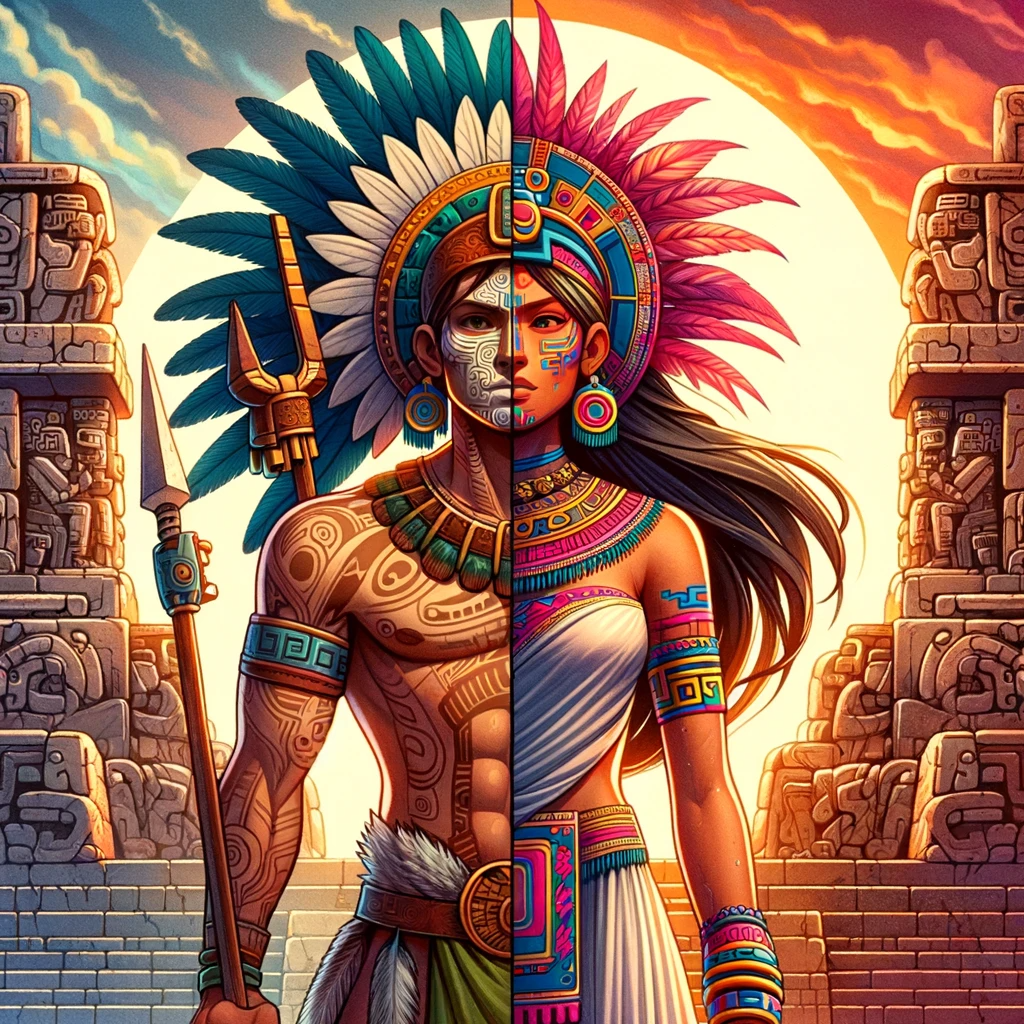
Ometecuhtli: The Dual God of the Aztecs
In the intricate and fascinating pantheon of the Aztec civilization, Ometecuhtli occupies a unique and significant position. Known as the dual god, Ometecuhtli is a deity that embodies the concept of duality, a central theme in Aztec mythology and cosmology. This article delves into the mythology, symbolism, and cultural significance of Ometecuhtli, offering insights into how this deity influenced the beliefs and practices of the Aztec people.
Origins and Mythology
Ometecuhtli, whose name means "Two Lord" in Nahuatl, the language of the Aztecs, is often depicted as a god with dual aspects, symbolizing the interconnection and balance of opposing forces in the universe. This deity is considered the lord of duality, embodying the essence of male and female, light and dark, and life and death.
Unlike many other Aztec deities who had distinct forms and temples, Ometecuhtli was not represented by specific idols or worshiped in a dedicated temple. This absence of physical representation underscores the abstract and all-encompassing nature of this deity.
Symbolism and Significance
Ometecuhtli is closely associated with the creation myth of the Aztec world. According to legend, Ometecuhtli dwelled in Omeyocan, the highest of the thirteen heavens, and played a vital role in the creation of the world and humankind. This deity is often linked with Ometeotl, another dual god representing the essence of the cosmic energy that permeates the universe.
The concept of duality that Ometecuhtli embodies is fundamental to understanding Aztec cosmology. The Aztecs believed that the balance of opposing forces was crucial for maintaining the harmony of the universe. This belief is evident in their rituals, art, and architecture, which often depict the coexistence of opposing elements.
Cultural Impact
Ometecuhtli's influence extended beyond religious beliefs into the everyday lives of the Aztec people. The idea of duality influenced Aztec social structures, gender roles, and the interpretation of natural phenomena. For example, the Aztecs viewed the interplay of male and female principles as essential for the continuation of life and the balance of the cosmos.
In Aztec rituals, offerings and ceremonies often sought to honor the balance of dual forces. Priests and worshipers would invoke Ometecuhtli's power to ensure harmony and balance in their communities and the natural world.
Legacy and Modern Interpretation
Today, Ometecuhtli remains a subject of interest among scholars and enthusiasts of Mesoamerican cultures. The deity's representation of duality is often seen as a precursor to modern concepts of balance and harmony in the universe. The study of Ometecuhtli provides valuable insights into the spiritual and philosophical underpinnings of the Aztec civilization.
Conclusion
Ometecuhtli, the dual god of the Aztecs, represents a complex and profound aspect of Aztec mythology. The deity's symbolism of duality and balance offers a window into the Aztec worldview, where opposing forces coexist in a delicate equilibrium. As we explore the rich tapestry of Aztec mythology, Ometecuhtli stands as a testament to the depth and sophistication of this ancient civilization's beliefs and cosmology.
In the intricate and fascinating pantheon of the Aztec civilization, Ometecuhtli occupies a unique and significant position. Known as the dual god, Ometecuhtli is a deity that embodies the concept of duality, a central theme in Aztec mythology and cosmology. This article delves into the mythology, symbolism, and cultural significance of Ometecuhtli, offering insights into how this deity influenced the beliefs and practices of the Aztec people.
Origins and Mythology
Ometecuhtli, whose name means "Two Lord" in Nahuatl, the language of the Aztecs, is often depicted as a god with dual aspects, symbolizing the interconnection and balance of opposing forces in the universe. This deity is considered the lord of duality, embodying the essence of male and female, light and dark, and life and death.
Unlike many other Aztec deities who had distinct forms and temples, Ometecuhtli was not represented by specific idols or worshiped in a dedicated temple. This absence of physical representation underscores the abstract and all-encompassing nature of this deity.
Symbolism and Significance
Ometecuhtli is closely associated with the creation myth of the Aztec world. According to legend, Ometecuhtli dwelled in Omeyocan, the highest of the thirteen heavens, and played a vital role in the creation of the world and humankind. This deity is often linked with Ometeotl, another dual god representing the essence of the cosmic energy that permeates the universe.
The concept of duality that Ometecuhtli embodies is fundamental to understanding Aztec cosmology. The Aztecs believed that the balance of opposing forces was crucial for maintaining the harmony of the universe. This belief is evident in their rituals, art, and architecture, which often depict the coexistence of opposing elements.
Cultural Impact
Ometecuhtli's influence extended beyond religious beliefs into the everyday lives of the Aztec people. The idea of duality influenced Aztec social structures, gender roles, and the interpretation of natural phenomena. For example, the Aztecs viewed the interplay of male and female principles as essential for the continuation of life and the balance of the cosmos.
In Aztec rituals, offerings and ceremonies often sought to honor the balance of dual forces. Priests and worshipers would invoke Ometecuhtli's power to ensure harmony and balance in their communities and the natural world.
Legacy and Modern Interpretation
Today, Ometecuhtli remains a subject of interest among scholars and enthusiasts of Mesoamerican cultures. The deity's representation of duality is often seen as a precursor to modern concepts of balance and harmony in the universe. The study of Ometecuhtli provides valuable insights into the spiritual and philosophical underpinnings of the Aztec civilization.
Conclusion
Ometecuhtli, the dual god of the Aztecs, represents a complex and profound aspect of Aztec mythology. The deity's symbolism of duality and balance offers a window into the Aztec worldview, where opposing forces coexist in a delicate equilibrium. As we explore the rich tapestry of Aztec mythology, Ometecuhtli stands as a testament to the depth and sophistication of this ancient civilization's beliefs and cosmology.